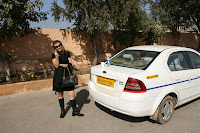

Needless to say Shaz was not impressed...
On the outskirts of Agra we stopped at Akbar’s Mausoleum where Shaz created a stir with the girls more than the boys showing a bit of knee..

 We were keen to walk a bit after the drive so we asked our 3 Star Hotel tour desk operator in which direction he’d recommend we walk.. He asked if we would be purchasing, because on our map it stated that tourists often liked to purchase in Agra, we said no, so he summed up the evening city sights of Agra in three words... “There are none…” We walked off anyway into the crush of peddle rickshaws and all our soon to be “friends”..
We were keen to walk a bit after the drive so we asked our 3 Star Hotel tour desk operator in which direction he’d recommend we walk.. He asked if we would be purchasing, because on our map it stated that tourists often liked to purchase in Agra, we said no, so he summed up the evening city sights of Agra in three words... “There are none…” We walked off anyway into the crush of peddle rickshaws and all our soon to be “friends”.. Next day we joined the dawn patrol at the World Heritage Taj Mahal (1631-1653). A few years back the government decided to limit cars and industry around the Taj as the white marble was turning yellow with acid rain.. Unfortunately when Agra lost favour and Delhi became the new centre Agra declined into an industrial city until the tourists hit.


The crisp winter morning was a great time to see the Taj before the pollution haze over the city was too thick and the hordes of tourists descend. It is a truly magnificent building. Shah Jahan was the local Mogul ruler in the mid-1600's. When his second wife Mumtaz Mahal, which means "beautiful wife" died giving birth to their fourteenth child at the young age of thirty-nine he was so heartbroken that his hair turned white overnight. Not satisfied with merely a change in hairstyle to express his grief, he decided to build a huge, elaborate mausoleum to his beloved, departed wife. Thus, the idea of the Taj Mahal was born. "Taj" means crown, and "Mahal" means palace. The year after his wife died, 1631 CE Shah Jahan had construction started on this monument. It was to be a tribute to her, and a show of his great love for her.




The architecture of the gates at which to enter such Mausoleums provides you a narrow view of the structure, once through the gate the expanse of the parks and the enormity of the scale can be fully realized. After seeing so many images of the Taj over the years it was amazing to finally be there to feel it.


Seeing the work that have gone into structures like these across the world is truly amazing. The books quote 20,000 worked on the Taj with much of the stonework and semiprecious stones making up the inlay work imported with the skilled tradesmen from Asia, Europe and Sri Lanka.


The massive red sandstone Agra Fort (1565) is the other major draw card, which continues a connection of love to the Taj, which can be seen across the banks of the Yamuna River. Shah Jahan, the builder of the Taj was imprisoned at the Fort by his son and was left to look over to the Taj for 8 years until his death.







No comments:
Post a Comment